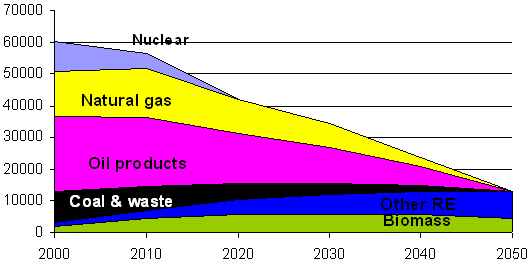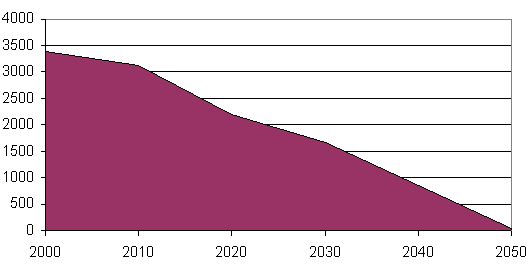Tiempo Climate Cyberlibrary
Vision 2050 for EU-15
- Tiempo archive
- Complete issues
- Selected articles
- Cartoons
- Climate treaty
- Latest news
- Secretariat
- National reports
- IPCC
About the Cyberlibrary
The Tiempo Climate Cyberlibrary was developed by Mick Kelly and Sarah Granich on behalf of the Stockholm Environment Institute and the International Institute for Environment and Development, with sponsorship from the Swedish International Development Cooperation Agency.
While every effort is made to ensure that information on this site, and on other sites that are referenced here, is accurate, no liability for loss or damage resulting from use of this information can be accepted.
|
Newswatch editor Sarah Granich reports on the launch of a new vision for a transition to sustainable energy in Europe by 2050. |
The International Network for Sustainable Energy in Europe (INFORSE-Europe) has launched its for transition to sustainable energy for the 15 "old" European Union countries - Vision 2050 for EU-15. INFORSE-Europe is a network of 63 citizens-based organizations throughout Europe promoting the sustainable development of energy.
Vision 2050 for EU-15 is based on the global Sustainable Energy Vision 2050 presented by INFORSE at the World Climate and Energy Event RIO 02. It present transitions for the 15 countries as a whole and for individual nations.
Vision 2050 foresees a phase out of nuclear and fossil energy, realized with greater use of renewable energy, but first of all with an increased use of energy efficiency.
|
|
|
Primary net energy supply for EU-15 (PJ) |
The high reliance on energy efficiency is based on the fact that many more energy efficient technologies will exist than those used today. It has been proven for most uses of energy that, with efficient technologies, just 10 to 25 per cent of the current energy consumption is needed. In Vision 2050, a forty-five-year transition period with a gradual increase in energy efficiency and in the use of renewable energy, is foreseen up to 2050.
Energy efficiency plays a significant part because it is expected to be cost-effective as mass-produced energy efficient products are, in many cases, only marginally more expensive than traditional, less efficient models. The small extra costs are easily saved with the reduced energy costs during the lifetime of the products.
The projected growth of renewable energy largely follows the development proposed until 2020 made by the European Renewable Energy Council which represents the renewable energy industry. Vision 2050 follows the European Union target of 12 per cent renewable energy in 2010 and the target proposed by a large number of non-governmental organizations for 25 per cent renewable energy in 2020. The shares of renewable energy in 2030 are 35 per cent, in 2040 65 per cent and in 2050 100 per cent.
The potential for an increase in energy efficiency on this scale has been documented by a number of expert groups, including the Factor 4 Club and the Factor 10 Club.
The Network asks whether higher efficiencies than those proposed in Vision 2050 are possible. They conclude that they have no doubt that higher efficiencies will be possible than the two- to four-fold increases included in the vision. But because of the current difficulties with realization of efficiency potentials in many European countries, the efficiencies have been limited to these levels. They note though, that it is proven that for individual industrial companies and houses a factor of four to ten is possible for an increase in efficiency. The challenge is to realize the efficiency on both national and international levels.
As far as biomass is concerned, the Network observes that biomass energy generation is expected to grow to about 90 per cent of the target for 2010 as set in the European Union's 1997 White Paper for Renewable Energy.
Current trends are well below this target but, because of a greater growth in windpower, the overall target of 12 per cent renewables by 2010 is maintained in Vision 2050. While a large part of the White Paper target is expected to be reached with biomass for heating, it is expected that biomass will later be used for cogeneration of heat and power. It could also be used for production of hydrogen for transport.
Energy trade is expected to be much less than today and, if the efficiency potentials are realized, then the European Union-15 might not be an energy importer after 2040. By 2050 it could even be exporting energy.
The reduction of carbon dioxide releases from energy use is expected to achieve the eight per cent Kyoto Protocol reduction target for 2010, followed by a 35 per cent reduction in 2020, a 50 per cent reduction by 2030, a 75 per cent reduction in 2040 and 100 per cent in 2050.
|
|
|
Carbon dioxide emissions for EU-15 (MT) |
To realize Vision 2050, INFORSE-Europe identifies the following four priorities:
- that the European Union target of 12 per cent renewable energy is realized by 2010. While some countries are well on their way to meeting this target, it still requires increased efforts in most of the countries;
- that the European Union should aim for an increase in the use of renewable energy to cover 25 per cent of energy consumption by 2020;
- that the two currently discussed European Union energy efficiency directives - the "energy service directive" and the "eco-design directive" - must be passed as soon as possible. Also, the proposed target of one per cent a year energy efficiency must be adopted and gradually increased to two per cent a year or more until 2010; and,
- that energy efficiency should be further promoted with clear labelling on all products showing the status of energy efficiency, together with minimum efficiency standards being set to take the most energy wasting products out of the market. Past success with the labelling on white goods shows that consumers do care for energy efficiency if the message and information provided is clear enough. The "eco-design directive" currently under discussion must be followed up with an improved directive for energy efficiency labels.
Within the framework of Vision 2050, INFORSE-Europe and member organizations worked on Europe-wide and on national visions to cover the transition. The Network notes that although it is beyond their scope to make detailed energy plans, the visions do include overviews of possible developments and indicators on how the changes can be made, sometimes including cost estimates.
The calculations for Vision 2050 are built on existing work such as energy scenarios, using the spreadsheet-based Tool for Development of National Visions that describes possible development decade by decade.
With inputs in the form of a current energy balance and trends for development in energy service demand, energy efficiency, a fuel shift and the development of renewable energy, it is possible, using the Tool, to make future energy balances following the criteria for Vision 2050. The Tool also calculates carbon dioxide emissions.
For further information about the Tool for Development of National Visions, which is available for use by non-governmental organizations in INFORSE and cooperating European networks, contact INFORSE-Europe.
Further information
Gunnar Boye Olesen, INFORSE-Europe coordinator,
International Network for Sustainable Energy, Gl. Kirkevej
82, DK-8530 Hjortshoj, Denmark. Fax: +45-86227096. Email:
ove@inforse.org. Web:
www.inforse.org/europe/.
On the Web
Full information about Vision 2050
Europe, together with projections and statistical
graphs, is available. The report includes details on the
European Union-15 Vision 2050 as well as information
regarding the national visions for Denmark, Slovakia,
Belarus, Ukraine and Romania. A background document on the
European
Union-15 Vision is also available.
Bright Ideas

General Electric plans to cut solar installation costs by half

Project 90 by 2030 supports South African school children and managers reduce their carbon footprint through its Club programme

Bath & North East Somerset Council in the United Kingdom has installed smart LED carriageway lighting that automatically adjusts to light and traffic levels

The United States National Oceanic and Atmospheric Administration and the American Public Gardens Association are mounting an educational exhibit at Longwood Gardens showing the link between temperature and planting zones

The energy-efficient Crowne Plaza Copenhagen Towers hotel is powered by renewable and sustainable sources, including integrated solar photovoltaics and guest-powered bicycles
El Hierro, one of the Canary Islands, plans to generate 80 per cent of its energy from renewable sources

The green roof on the Remarkables Primary School in New Zealand reduces stormwater runoff, provides insulation and doubles as an outdoor classroom

The Weather Info for All project aims to roll out up to five thousand automatic weather observation stations throughout Africa

SolSource turns its own waste heat into electricity or stores it in thermal fabrics, harnessing the sun's energy for cooking and electricity for low-income families

The Wave House uses vegetation for its architectural and environmental qualities, and especially in terms of thermal insulation

The Mbale compost-processing plant in Uganda produces cheaper fertilizer and reduces greenhouse gas emissions

At Casa Grande, Frito-Lay has reduced energy consumption by nearly a fifth since 2006 by, amongst other things, installing a heat recovery system to preheat cooking oil
Updated: May 15th 2015

